Mastering how to learn is just as important as mastering what you learn — and the SQ3R method is one of the most effective study techniques for doing exactly that. Developed by psychologist Francis P. Robinson, this proven five-step strategy helps readers actively engage with material, boost comprehension, and retain information longer. Whether you’re a student, professional, or lifelong learner, understanding and applying the SQ3R method can transform the way you absorb knowledge and achieve academic or career success.
SQ3R Method: What It Is and Why It Matters
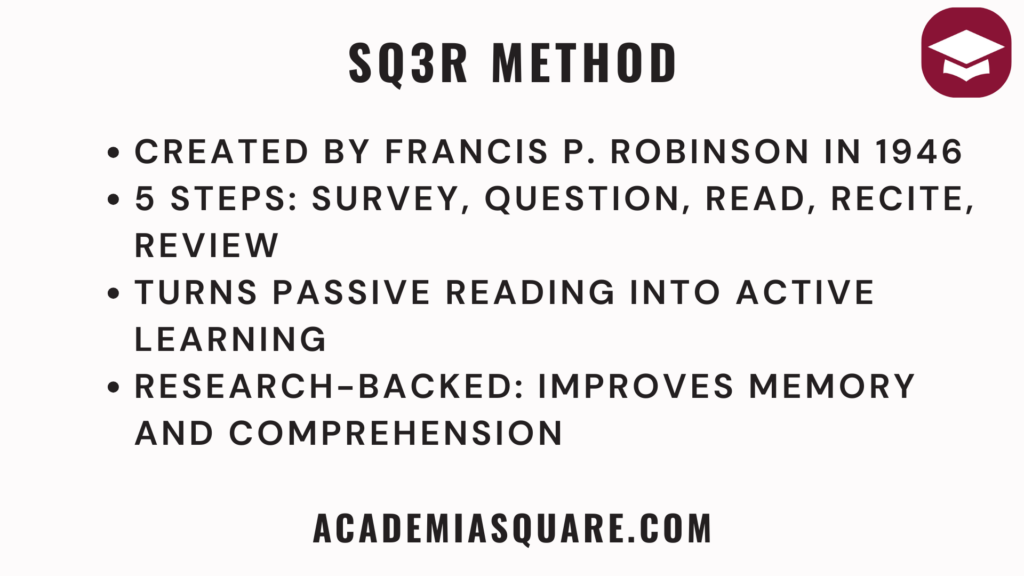
When it comes to mastering any complex subject, having the right study strategy can make the difference between success and struggle. The SQ3R method stands out as one of the most effective techniques for improving reading comprehension and retention. Developed by psychologist Francis P. Robinson in 1946, SQ3R remains highly relevant today because it is rooted in strong cognitive science principles that promote active engagement with material.
At its core, the SQ3R method is a structured, five-step reading process designed to help you understand, organize, and remember what you read. The acronym SQ3R stands for:
- Survey
- Question
- Read
- Recite
- Review
Each step builds upon the previous one, creating a loop of interaction that forces the brain to actively process information instead of passively scanning it.
Why Traditional Reading Doesn’t Work
Most people approach reading in a passive way—glancing through chapters, underlining a few phrases, and hoping the knowledge sticks. Unfortunately, research shows that passive reading leads to shallow understanding and quick forgetting. According to studies published in the journal Memory & Cognition, without active engagement, more than 50% of newly learned information is forgotten within an hour.
The SQ3R method combats this natural forgetting curve by forcing you to interact with the material at multiple points. It turns reading into an active conversation between you and the text, significantly boosting your ability to retain and apply information.
The Power of Active Reading: What Science Says
Modern cognitive science strongly backs active reading techniques like SQ3R. Research on active recall—the practice of retrieving information without looking at your notes—shows that it is one of the most powerful methods to cement learning. Studies from institutions like Stanford and MIT consistently reveal that techniques involving questioning, summarizing, and reviewing drastically outperform simple re-reading or highlighting.
In fact, when combined with regular review sessions (another key component of SQ3R), retention rates can increase by up to 80% compared to passive study methods.
Who Benefits Most from the SQ3R Method?
While originally designed for college students struggling with heavy reading loads, today the SQ3R method is used by a wide range of learners, including:
- High school students preparing for major exams
- University students managing dense academic texts
- Professionals needing to absorb reports, white papers, or technical documentation
- Self-learners aiming to master new skills or knowledge areas independently
Regardless of your learning stage or goals, integrating the SQ3R method into your study routine can help you extract maximum value from every reading session.
Quick Overview: What Makes SQ3R Stand Out
Here’s a quick checklist summarizing why SQ3R is worth mastering:
- ✔️ Encourages active engagement instead of passive reading
- ✔️ Breaks down complex material into manageable steps
- ✔️ Boosts comprehension, retention, and critical thinking
- ✔️ Supported by decades of educational research
- ✔️ Adaptable to different fields and types of content
By the end of this blog post, you will not only understand each step in depth but also know exactly how to implement SQ3R to transform your learning process.
The Science Behind SQ3R: Cognitive Foundations
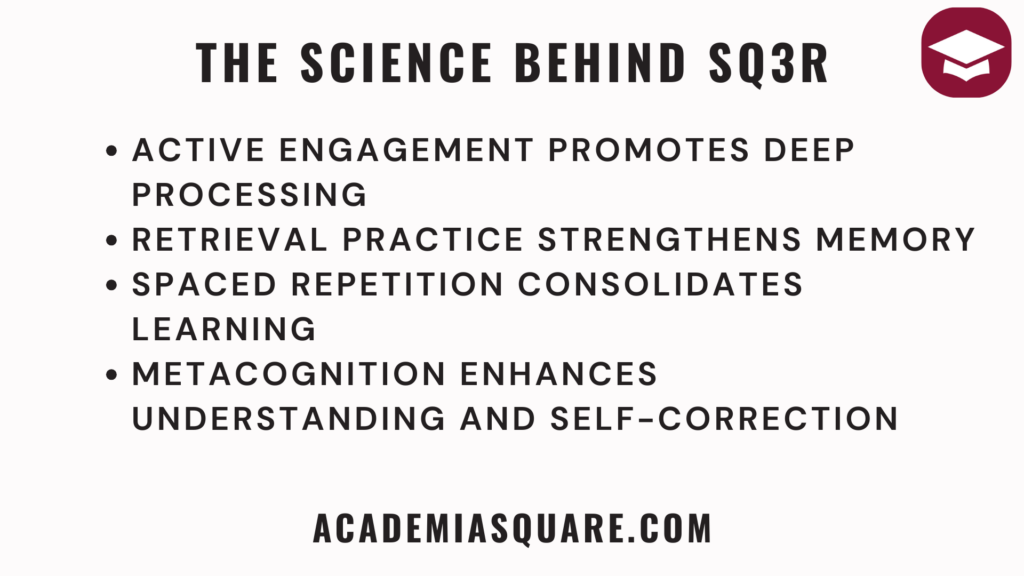
The effectiveness of the SQ3R method isn’t accidental. It taps into fundamental cognitive principles that explain how we learn, store, and retrieve information. By understanding the science behind it, you’ll appreciate why each step of SQ3R is carefully designed to optimize your brain’s natural learning processes.
Active Engagement and Deep Processing
One of the key reasons SQ3R works is because it demands active engagement with the material. Psychologists Craig and Lockhart’s Levels of Processing Theory (1972) proposed that the depth at which information is processed has a direct impact on how well it is remembered. The deeper the processing — like analyzing, questioning, and paraphrasing — the stronger the memory trace becomes.
The SQ3R method promotes deep processing by requiring you to:
- Survey and predict the content
- Formulate questions about it
- Read with purpose
- Recite the information in your own words
- Review and reflect over time
This continual interaction ensures that information is not just seen or heard but genuinely understood and internalized.
The Power of Retrieval Practice
Another pillar of cognitive science supporting SQ3R is retrieval practice. This refers to the act of pulling information out of your memory without cues — exactly what you do during the “Recite” and “Review” phases. Studies like Roediger & Butler (2011) have demonstrated that retrieval practice enhances long-term retention significantly more than passive review.
When you recite information from memory instead of re-reading it, you strengthen the neural pathways associated with that knowledge. Think of it like exercising a muscle: the more you retrieve, the stronger the memory becomes.
Spaced Repetition and Memory Consolidation
Memory researchers such as Ebbinghaus have long shown that reviewing information over spaced intervals leads to better long-term retention. This concept, known as the spacing effect, is naturally built into the “Review” stage of SQ3R. Instead of cramming all information in one sitting, you revisit it multiple times, allowing your brain to consolidate the information more effectively.
Key benefits of spaced repetition included in SQ3R:
- ✔️ Reduces the forgetting curve
- ✔️ Strengthens long-term memory storage
- ✔️ Improves the ability to apply knowledge flexibly
By scheduling regular review sessions after your initial reading, you ensure that information moves from short-term memory into durable long-term memory stores.
Metacognition: Thinking About Thinking
Metacognition — your ability to monitor and regulate your own learning — is another cognitive principle embedded in SQ3R. When you ask questions (the “Q” step) and summarize information (the “Recite” step), you are engaging in metacognitive activities that help you assess your understanding in real-time.
According to a 2014 meta-analysis published in the journal Psychological Science in the Public Interest, students who use metacognitive strategies like self-questioning and summarizing score significantly higher on tests compared to those who don’t. SQ3R naturally nurtures this reflective mindset by encouraging constant evaluation of what you know and what you still need to learn.
Step 1 – Survey: Building a Mental Framework
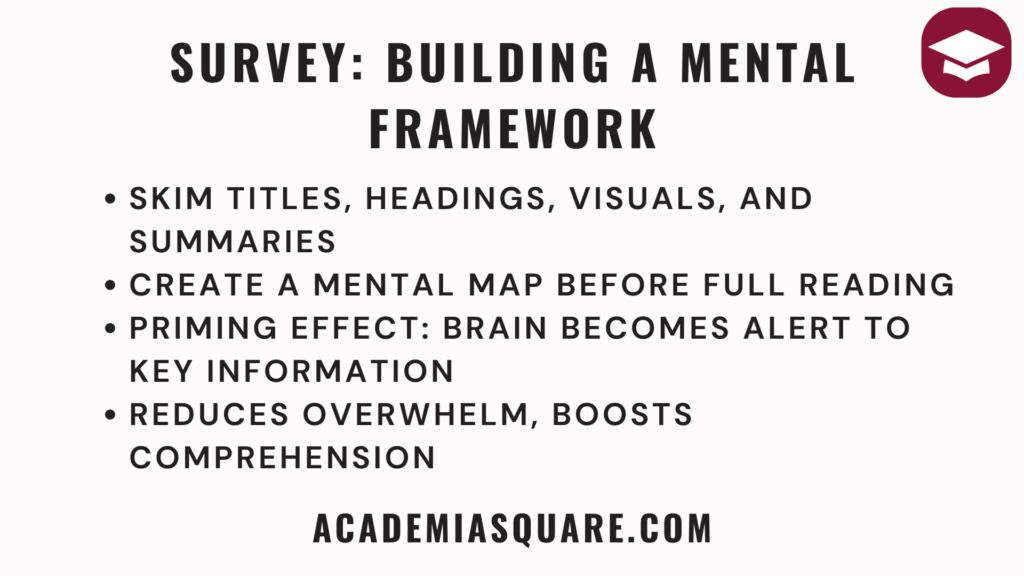
The first step of the SQ3R method is Survey — and it’s one of the most overlooked, yet essential parts of effective reading. Surveying a text before diving in builds a mental roadmap that guides your understanding. Instead of reading blindly, you’re preparing your brain to recognize patterns, anticipate key points, and connect new information with what you already know.
Why Surveying Matters
Imagine trying to assemble a puzzle without seeing the final picture on the box. You would spend hours guessing where each piece fits. Surveying is like studying that picture first — giving you a clear context that makes everything easier to organize and remember.
Studies on advance organizers, a concept introduced by educational psychologist David Ausubel, show that learners who preview material before studying perform significantly better than those who do not. By surveying, you create a scaffold in your brain that supports deeper comprehension and stronger recall later.
How to Effectively Survey a Text
Surveying isn’t about speed-reading or skimming mindlessly. It’s a strategic overview of the structure and main ideas of a text. To survey properly, focus on the following elements:
- Title and subtitles: These give you immediate clues about the primary themes and organizational structure.
- Introduction and conclusion: Most authors state their goals, arguments, or findings clearly at the beginning and end.
- Headings and subheadings: They reveal how the content is broken down and what topics will be addressed.
- Bolded terms, bullet points, or highlighted sections: These typically signal key concepts or crucial information.
- Graphs, charts, and images: Visual data often summarizes complex ideas in digestible formats.
- Summary sections: If available, these condense the chapter’s main arguments and findings into a few paragraphs.
Spending just 5 to 10 minutes surveying can dramatically change how you absorb the material during the reading phase.
The Psychological Edge: Priming Your Brain
Surveying works because it takes advantage of a cognitive phenomenon called priming. When you expose your brain to the general ideas of a topic beforehand, you create mental “hooks” for the details you’ll encounter later. It becomes easier to recognize important points, categorize them meaningfully, and weave them into existing knowledge.
Priming doesn’t just improve memory; it also increases reading efficiency. When you know what to look for, you naturally filter out less important information and focus more attention where it matters most. A study published in the Journal of Educational Psychology found that students who used preview strategies like surveying had 30% higher comprehension scores compared to those who didn’t.
Common Mistakes When Surveying (and How to Avoid Them)
While the concept of surveying is simple, it’s easy to fall into traps that reduce its effectiveness. Some common mistakes include:
- Rushing through the preview: Taking too little time leaves you without a clear mental map.
- Skipping structural elements: Ignoring headings, summaries, or visuals causes you to miss valuable organizational clues.
- Passive skimming: Simply glancing at the page without mentally engaging defeats the purpose.
To avoid these mistakes, approach surveying as an active exploration. Ask yourself questions like: “What seems to be the main idea?” or “How is this section connected to what I already know?” Doing this transforms surveying from a passive glance into a strategic setup for deep learning.
Key Takeaway: Survey Sets the Stage
Surveying isn’t about rushing ahead; it’s about laying the groundwork for everything that follows. A few minutes spent properly surveying will help you engage more critically, retain information longer, and read more efficiently when you dive into the full text. In the next step, we’ll explore how asking the right questions before reading further supercharges your comprehension.
Step 2 – Question: Engaging Curiosity
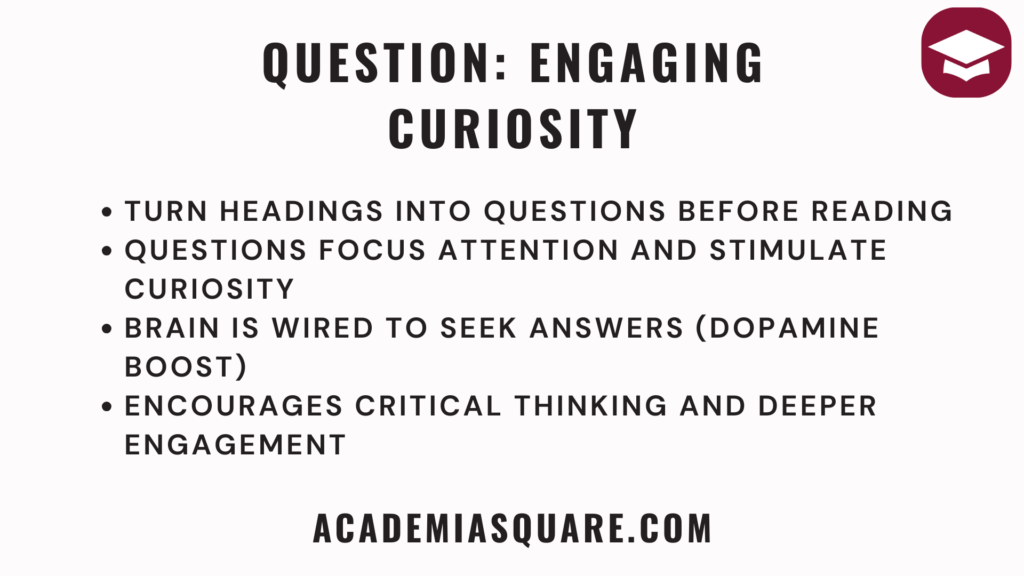
After surveying a text and gaining an initial overview, the next critical step in the SQ3R method is Question. Formulating questions before reading might seem like a small step, but it radically transforms how your brain processes information. Instead of passively absorbing words, you become an active investigator, searching for answers — a strategy strongly supported by educational psychology research.
Why Asking Questions Boosts Learning
According to a landmark study published in the Journal of Experimental Psychology, readers who pose questions before and during reading demonstrate higher comprehension and recall rates than those who do not. The simple act of asking questions directs your attention toward finding specific information and promotes deeper engagement with the material.
When you read with questions in mind, you activate what psychologists call elaborative interrogation. This technique forces your brain to make connections between new knowledge and existing understanding, significantly strengthening memory pathways.
How to Generate Effective Questions
Creating useful questions is not about complexity; it’s about relevance. You want questions that naturally lead you to focus on the important aspects of the material. Here are practical strategies for crafting effective questions:
- Use headings and subheadings: Turn them into questions. For example, a section titled “Causes of World War I” becomes “What were the causes of World War I?”
- Ask about purpose: “Why did the author include this section?” or “What problem is this theory trying to solve?”
- Predict key points: Based on your survey, ask, “What arguments will the author likely make?”
- Challenge assumptions: Frame questions like, “Is there evidence to support this claim?” or “How does this compare to other perspectives I know?”
Effective questioning doesn’t require dozens of queries. Even forming three to five solid questions per chapter or section can sharpen your focus dramatically during reading.
The Psychology Behind Curiosity and Focus
Modern neuroscience studies, particularly those using fMRI brain scans, reveal that curiosity increases dopamine activity in the brain. Dopamine not only boosts motivation but also enhances the hippocampus’s ability to encode and store memories. In simple terms, when you’re curious, you are neurologically primed to learn faster and retain more information.
By deliberately asking questions, you manufacture curiosity even when the subject might initially seem dry or complex. You create a mental itch — and reading becomes the process of scratching it.
Examples of High-Quality Questions by Subject
To illustrate how versatile this strategy is, here are examples of how you can tailor questions based on different types of reading material:
- History: “What were the underlying causes of this event?” “Who were the key figures, and what were their motivations?”
- Science: “What hypothesis is being tested?” “What evidence supports the conclusion?”
- Business: “What problem is this strategy addressing?” “What are the potential limitations or risks?”
- Literature: “What themes are emerging?” “How does the setting influence the characters’ decisions?”
By customizing your questions to the subject matter, you ensure that your reading sessions are purpose-driven and aligned with deeper learning goals.
Key Takeaway: Questions Are the Engine of Active Reading
Asking purposeful questions transforms reading from a passive reception of information into an active, goal-oriented investigation. It primes your brain to seek, sort, and store information far more effectively than reading without a plan. In the next step, we’ll look at how the “Read” phase of the SQ3R method builds upon this foundation by turning answers into deeper understanding.
Step 3 – Read: Active Reading Strategies
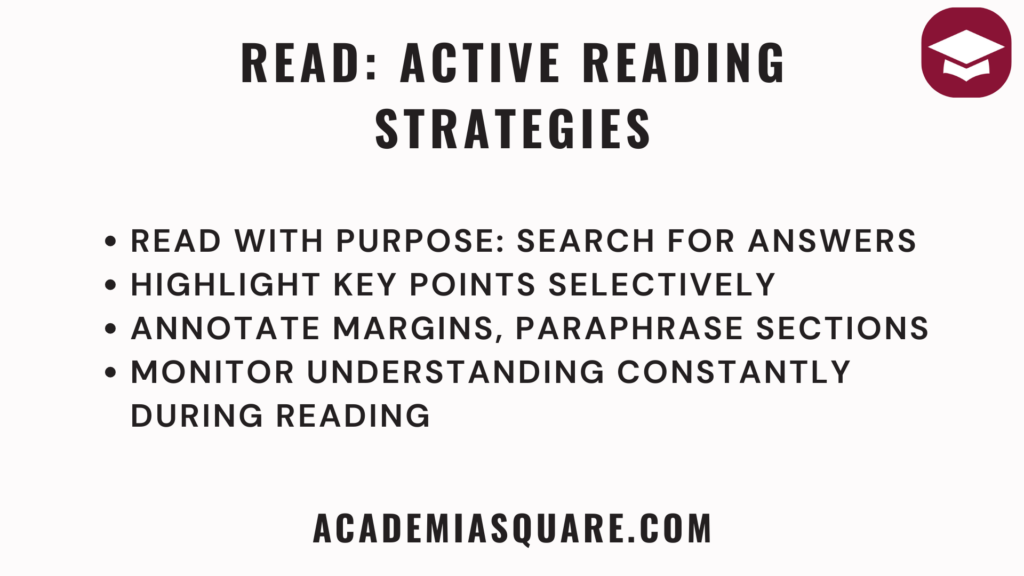
After surveying the material and formulating questions, you are ready to move into the heart of the SQ3R method: Read. However, reading in this phase is not about passively scanning words. It’s about active reading — a method where you engage with the content, search for answers to your questions, and think critically about the information presented.
Active reading transforms your study sessions from a time-consuming chore into a focused, purposeful process. Instead of getting lost in endless paragraphs, you move through the material with a clear mission, making your study time dramatically more efficient and rewarding.
What Does Active Reading Look Like?
Active reading involves interacting with the text on multiple levels. It means highlighting important points, annotating margins with comments or questions, and mentally summarizing sections as you go. You’re not just reading — you’re analyzing, questioning, and connecting ideas continuously.
According to a study published in the Review of Educational Research, students who engage in annotation and summarization during reading score significantly higher in comprehension and retention tests than those who read silently without interaction.
Strategies for Effective Active Reading
To maximize the benefits of the “Read” phase, incorporate these proven strategies:
- Answer your pre-formed questions: As you read, actively look for answers to the questions you created in the “Question” phase. This keeps your focus sharp and purposeful.
- Highlight selectively: Avoid highlighting entire paragraphs. Instead, focus on key terms, definitions, crucial arguments, or evidence that directly addresses your questions.
- Write margin notes: Briefly jot down summaries, thoughts, or additional questions as they occur. This interaction cements your understanding.
- Pause and paraphrase: At the end of each section, pause to mentally summarize what you just read. Putting it into your own words forces deeper processing and checks your understanding.
- Make connections: Relate the material to previous knowledge, real-world examples, or other topics you’ve studied. The more associations you form, the stronger your memory of the content becomes.
The Role of Self-Monitoring
During active reading, it’s important to practice self-monitoring — constantly asking yourself whether you understand what you’re reading. If you find yourself zoning out or simply moving your eyes across the page without absorbing meaning, it’s a signal to stop and re-engage with the text.
Self-monitoring is part of metacognition, the process of thinking about your own learning. Research from the American Educational Research Association shows that students who frequently self-monitor during reading have greater academic success than those who don’t. Simply asking, “Do I get this?” at regular intervals can sharply improve comprehension rates.
Common Pitfalls to Avoid While Reading
Even with good intentions, it’s easy to fall into traps that make reading less effective. Be mindful of these common mistakes:
- Highlighting too much: Turning the entire page yellow dilutes the value of highlighting. Be selective and strategic.
- Reading without goals: Skipping the Question phase leads to unfocused reading and poor retention.
- Skipping mental summaries: Failing to paraphrase and reflect after sections results in shallow understanding.
- Ignoring unfamiliar words or concepts: Always take a moment to look up or clarify confusing points. Gaps in understanding can widen quickly.
Key Takeaway: Read to Find, Understand, and Connect
The “Read” phase of SQ3R isn’t about passively moving through pages. It’s about interacting deeply with the content, using your questions as a guide, and constantly checking your understanding. This active engagement turns reading into a powerful learning experience, setting you up perfectly for the next phase: Reciting what you’ve learned to further reinforce memory and comprehension.
Step 4 – Recite: Reinforcing Memory
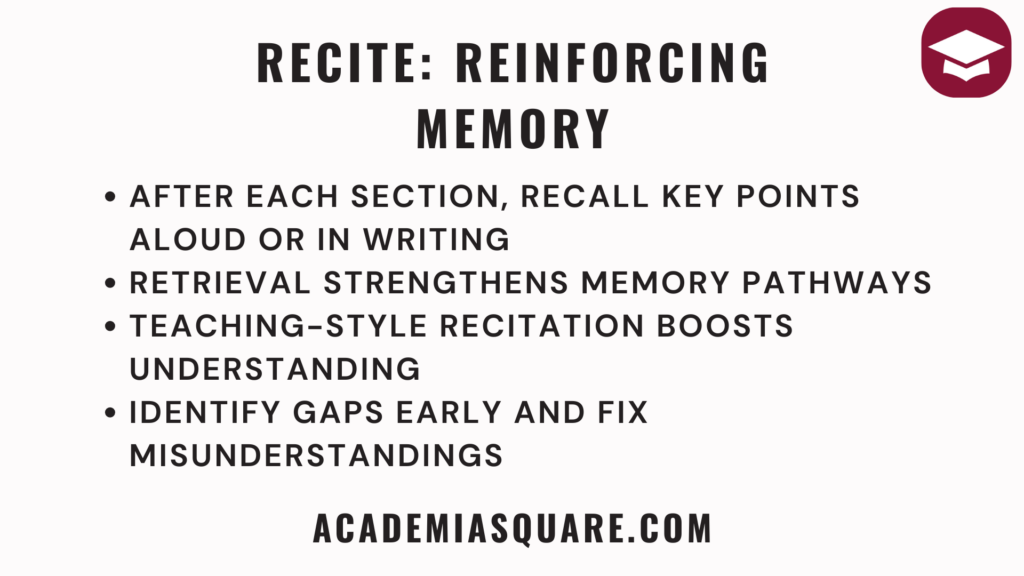
After actively reading and finding answers to your questions, the next crucial step in the SQ3R method is Recite. This phase often gets skipped by learners in a hurry — but doing so costs you enormous gains in memory retention and understanding. Reciting consolidates knowledge by forcing you to retrieve and reconstruct information, strengthening the neural pathways involved in learning.
Why Recitation Is Critical for Memory
Research consistently shows that retrieval practice — the act of recalling information without looking at notes — is one of the most powerful ways to strengthen memory. A landmark 2008 study published in the journal Science found that students who practiced retrieving information retained nearly 50% more over time compared to students who simply reviewed the material passively.
Reciting immediately after reading embeds the material more deeply because it transforms passive knowledge into active knowledge. It also reveals gaps in your understanding, allowing you to correct them quickly rather than letting misunderstandings linger.
How to Effectively Recite
Effective recitation isn’t about rote repetition. It’s about putting information into your own words and explaining it clearly, as if teaching someone else. Here’s how to approach it:
- Look away from the material: After reading a section, close the book or hide the text and try to recall the key points aloud or in writing.
- Summarize actively: Summarize the section using your own language. Avoid parroting sentences directly from the text.
- Answer your initial questions: Revisit the questions you created during the “Question” phase and try to answer them from memory.
- Teach it out loud: Pretend you’re explaining the concept to a friend or study partner. Teaching forces a deeper reorganization of the knowledge.
Even brief recitation sessions (2–5 minutes after each major section) can dramatically improve how much you remember later.
The Psychological Mechanism Behind Recitation
Recitation works by engaging the principle of active retrieval. When you pull information from memory rather than simply re-reading it, you are practicing the same mental processes that you will use later in real-world situations — like exams, meetings, or applying knowledge professionally.
Moreover, retrieval practice causes a phenomenon known as retrieval-induced consolidation, strengthening the neural traces of memory and making future retrieval faster and easier. Over time, this makes accessing the learned information feel almost automatic.
Common Mistakes During Recitation (and How to Avoid Them)
As simple as reciting sounds, it’s easy to fall into ineffective habits that reduce its benefits. Be mindful to avoid:
- Reciting with the book open: Having the material in front of you tempts you to peek and reduces the effectiveness of retrieval.
- Being too vague: “I get the idea” is not enough. Be specific in your recall; details matter.
- Reciting only once: Memory strengthens with repetition. Build short, spaced recitation sessions to solidify learning.
Good recitation practices involve both effort and precision. The more you strain to recall accurately, the stronger your memory becomes over time.
Key Takeaway: Recitation Builds Durable, Flexible Knowledge
Recitation is not just an optional review step; it is an active construction of memory. When you recite regularly after reading, you embed the material deeper into your long-term memory, making it easier to retrieve when it matters most. In the next chapter, we’ll move to the final critical phase: Review — the step that ensures your hard work pays off over the long term.
Step 5 – Review: Consolidating Knowledge
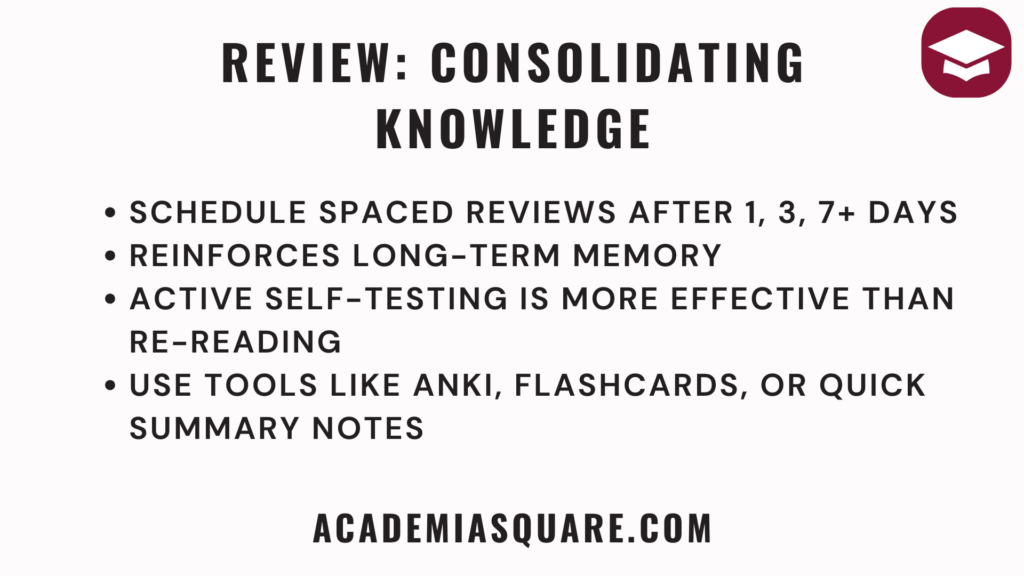
After surveying, questioning, reading, and reciting, the final step of the SQ3R method is Review. Review isn’t just a quick glance back at the material — it’s a deliberate, strategic process aimed at transferring information from short-term to long-term memory. Without this final phase, much of what you learned risks being forgotten within days.
Studies on memory, beginning with Hermann Ebbinghaus’s research in the 19th century, demonstrate the inevitability of the forgetting curve — a steep decline in memory retention that occurs soon after initial learning. The review process is designed specifically to combat this curve by reinforcing and reactivating neural pathways before they weaken.
What Makes an Effective Review?
Effective review isn’t about reading the material passively over and over. It’s about active, spaced repetition — strategically revisiting the material at intervals to strengthen your grasp over time.
Here’s how to conduct a powerful review:
- Initial review: Soon after completing the reading and recitation phases, spend 5–10 minutes reviewing key points, summaries, and answers to your original questions.
- First spaced review: Return to the material after 24 hours. Attempt to recall key information before consulting your notes.
- Ongoing spaced reviews: Review again at increasing intervals — for example, after 3 days, one week, and two weeks.
- Recreate notes: Rewrite summaries or concept maps from memory. This act of reconstruction is highly effective for deepening understanding.
- Self-testing: Use flashcards or practice quizzes to actively engage retrieval processes during review sessions.
Each review session doesn’t need to be long; even 10–15 minutes can produce strong reinforcement when scheduled effectively.
The Science of Spaced Repetition
Spaced repetition leverages the spacing effect — a phenomenon first observed by Ebbinghaus — which states that information reviewed at increasing intervals is retained much more effectively than information crammed in a single session. Modern research continues to confirm this principle. A 2007 study in Applied Cognitive Psychology found that students who spaced their study sessions outperformed massed learners by wide margins, especially on long-term assessments.
The Review step of SQ3R naturally incorporates spaced repetition, turning each encounter with the material into a reinforcement opportunity rather than a repetition of earlier mistakes.
Tools to Enhance Your Review Sessions
Today, many learners use technology to support their review process. While traditional methods like paper flashcards and handwritten summaries remain effective, digital tools can help automate and optimize the spaced repetition schedule. Useful resources include:
- Anki: A powerful flashcard app based on spaced repetition algorithms.
- Quizlet: Useful for creating and practicing custom quizzes and flashcards.
- Notion or Obsidian: Note-taking apps that allow you to link ideas and schedule reviews systematically.
Regardless of the tools you use, the key principle remains the same: consistent, active, spaced review transforms short-term gains into lasting knowledge.
Common Pitfalls to Watch Out For
As with the other SQ3R steps, reviewing incorrectly can undermine your learning efforts. Be careful to avoid:
- Passive rereading: Simply scanning over material without effortful retrieval does little to strengthen memory.
- Irregular scheduling: Skipping review sessions or spacing them inconsistently reduces the benefits of spaced repetition.
- Overconfidence: Believing you “know it” too soon and abandoning review prematurely leads to rapid forgetting.
Key Takeaway: Review Locks Learning into Long-Term Memory
Reviewing is not an afterthought; it is the engine that cements everything you’ve worked hard to learn. By systematically revisiting and retrieving information, you ensure that knowledge stays accessible and useful long after your initial study session. With the five steps of SQ3R now fully explained, we can explore how to adapt and apply this method across different disciplines and learning environments.
SQ3R in Action: Applying the Method Across Disciplines
One of the greatest strengths of the SQ3R method is its adaptability. Whether you are studying history, physics, business, or literature, the five steps of Survey, Question, Read, Recite, and Review can be molded to fit the demands of any subject. By adjusting how you apply each step, you can optimize your study sessions and better tackle the unique challenges posed by different fields of knowledge.
Applying SQ3R in Humanities and Social Sciences
Subjects like history, psychology, and sociology often involve dense reading materials filled with theories, arguments, and historical facts. In these areas, SQ3R helps by structuring your reading and focusing your attention on relationships between ideas rather than isolated facts.
- Survey: Pay close attention to chapter summaries, timelines, and argument structures before diving into the full text.
- Question: Ask about causes and effects, motives of historical figures, or implications of theories.
- Read: Actively track arguments and note counterarguments or supporting evidence.
- Recite: Summarize key events, thinkers, and theories in your own words after each section.
- Review: Regularly revisit major themes, movements, and conceptual frameworks to reinforce long-term understanding.
Because these fields often require essay writing, using SQ3R sharpens your ability to recall facts and critically analyze ideas — essential skills for crafting strong arguments and interpretations.
Applying SQ3R in STEM Fields
When dealing with science, technology, engineering, and mathematics (STEM) subjects, the focus shifts slightly. Here, understanding processes, solving problems, and applying formulas are key. SQ3R remains powerful, but with a slight tactical adjustment toward problem-solving and concept application.
- Survey: Identify the key formulas, processes, and models presented. Note figures, diagrams, and sample problems.
- Question: Formulate questions like “What problem does this formula solve?” or “How does this process work step-by-step?”
- Read: Focus deeply on examples and worked solutions, noting assumptions and common patterns.
- Recite: Re-explain processes, derive formulas, and walk through problem-solving methods without looking at the book.
- Review: Rework old problems, test yourself with new ones, and link similar types of problems together.
STEM subjects demand not just recognition but application. Reciting by solving problems from scratch and reviewing by practicing variations solidifies both theory and method.
Applying SQ3R to Business and Professional Studies
Fields like business, management, and law require reading that is often strategic and application-driven. Texts in these areas mix theory with real-world examples, making SQ3R an excellent strategy to distill actionable knowledge.
- Survey: Identify case studies, frameworks, and key strategies before reading the full content.
- Question: Frame questions like “What problem is this business strategy solving?” or “How can this law be applied in practice?”
- Read: Pay attention to examples, key outcomes, and contextual applications of theories.
- Recite: Summarize case study takeaways, laws, or frameworks in your own words and think about how you might apply them.
- Review: Regularly revisit frameworks and applications through mock case studies or hypothetical scenarios.
Because professional disciplines often emphasize decision-making, the SQ3R method ensures you not only understand concepts but also practice applying them in diverse situations.
Why Adaptation Matters
Every subject demands a slightly different lens of understanding. Memorizing historical dates is different from mastering chemical reactions, and applying legal precedents is different from solving mathematical equations. The power of SQ3R lies in its flexibility: it gives you a system, but it allows you to adapt that system to fit the specific cognitive demands of any discipline.
Mastering this adaptability is what elevates SQ3R from a helpful method to an indispensable learning tool. In the next chapter, we’ll discuss common challenges people face when implementing SQ3R — and how to overcome them effectively to make the method truly your own.
Enhancing SQ3R with Modern Tools
While the original SQ3R method was developed in the 1940s, today’s learners have access to a wide array of digital tools and technologies that can enhance and streamline the method. By thoughtfully integrating technology into each step, you can make your study sessions more efficient, organized, and impactful. The key is to use tools that support active learning rather than distract from it.
Survey: Organizing Previews with Digital Notes
Surveying is faster and more strategic when you use digital note-taking platforms. Tools like Notion, Evernote, or Microsoft OneNote allow you to create quick outlines of a textbook or article’s structure. You can easily capture headings, subheadings, and key visuals in an organized format that’s searchable and expandable as you dive deeper into the material.
For ebooks or online articles, browser extensions like Evernote Web Clipper or OneNote Web Clipper can help you extract and organize important sections quickly, making the Survey step more structured and actionable.
Question: Boosting Curiosity with Digital Prompts
Formulating questions becomes even more powerful when you use dedicated apps or tools. Apps like Obsidian allow you to build a web of interconnected questions and answers through bi-directional links, promoting deeper engagement and critical thinking.
Some learners also use spaced repetition flashcard systems like Anki to create decks specifically around the questions generated during the SQ3R process. Instead of relying on memory alone, you have a systematic way to revisit and refine your questions over time.
Read: Enhancing Active Reading Digitally
Modern reading platforms offer annotation features that support active reading beautifully. Tools like Kindle, GoodNotes (for PDFs and ebooks), and MarginNote allow you to highlight, comment, and even create mind maps directly from your readings.
- Highlight key answers as you find them.
- Add margin notes summarizing paragraphs or asking further questions.
- Create visual maps to track relationships between ideas as you read.
These tools help ensure that reading remains active, not passive, even when working with digital texts.
Recite: Using Voice and Video for Recall
Reciting traditionally involves speaking aloud or writing summaries. With technology, you can amplify this by recording yourself explaining concepts using simple tools like your smartphone’s voice recorder, Otter.ai for transcription, or even short selfie videos.
Listening back or watching your recitations allows you to spot gaps, misunderstandings, or areas that need reinforcement — an extra layer of reflection that handwritten notes alone might miss.
Another approach is creating short presentations (using Canva or PowerPoint) where you teach the material to an imaginary audience. This technique combines retrieval, organization, and articulation skills into one powerful exercise.
Review: Automating Spaced Repetition
Reviewing at strategic intervals is crucial, and modern apps can automate this process to perfection. Apps like Anki and RemNote are specifically built around spaced repetition algorithms, ensuring you review information just as you’re about to forget it — maximizing long-term retention with minimal wasted effort.
Additionally, calendar apps like Google Calendar can be used to schedule larger review sessions after 1 day, 3 days, 7 days, and beyond, reinforcing the rhythm recommended by memory science.
Key Takeaway: Technology Supercharges Traditional Methods
Modern tools don’t replace the wisdom of the SQ3R method — they enhance it. By integrating apps and digital platforms thoughtfully at each stage, you can make your learning more dynamic, interactive, and resilient. In the next chapter, we’ll see how SQ3R compares to other study methods and why it remains one of the most effective strategies for deep learning today.
Comparing SQ3R to Other Study Methods
The SQ3R method is widely recognized for its structured approach to learning, but it’s not the only study strategy available. To fully appreciate the strengths of SQ3R, it’s helpful to compare it to other popular methods such as PQ4R, the Feynman Technique, and simple re-reading or highlighting strategies. Each has its merits, but SQ3R offers a uniquely comprehensive blend of active engagement, comprehension, and memory reinforcement.
SQ3R Method vs. PQ4R
PQ4R stands for Preview, Question, Read, Reflect, Recite, and Review. It was developed as an evolution of SQ3R to place greater emphasis on reflection during learning. In PQ4R, after reading, you consciously reflect on the material before trying to recite it. This reflection phase encourages deeper critical thinking about the material’s meaning and applications.
While PQ4R adds an important step, SQ3R remains slightly more streamlined, making it easier for beginners or those studying large volumes of information quickly. SQ3R’s efficiency is one of its key advantages, especially for learners who need a strong foundation before layering on more complex reflection techniques later.
SQ3R Method vs. The Feynman Technique
The Feynman Technique, named after Nobel Prize-winning physicist Richard Feynman, revolves around one core idea: if you can’t explain a concept in simple terms, you don’t really understand it. The process involves studying a topic, writing out an explanation as if teaching a child, identifying gaps in your understanding, and simplifying the explanation further.
While the Feynman Technique is incredibly powerful for deep conceptual mastery, it assumes that you have already processed and internalized the basic material. It does not provide a full roadmap for first-time reading comprehension and information gathering the way SQ3R does. In this sense, SQ3R serves as a perfect precursor: it builds the comprehension foundation necessary for Feynman-style mastery later.
SQ3R vs. Passive Strategies: Re-Reading and Highlighting
Many students rely heavily on re-reading their textbooks or highlighting large sections of text, believing these practices reinforce learning. However, substantial research shows that passive review methods are among the least effective for long-term retention.
A 2013 meta-analysis published in the journal Psychological Science in the Public Interest concluded that re-reading and highlighting produced minimal learning gains compared to active strategies like retrieval practice and elaborative interrogation. Simply put, re-reading and highlighting often create an illusion of familiarity without genuine understanding or memory strengthening.
In contrast, SQ3R’s structure forces active involvement with the material at every stage — from prediction and questioning to recitation and spaced review — making it far superior for students serious about true comprehension and retention.
When to Use Each Method
It’s important to recognize that no single method fits every situation perfectly. Depending on your learning goals, different strategies may be better suited:
- Use SQ3R when first encountering complex material, especially textbooks, academic papers, or dense nonfiction.
- Use PQ4R when you want to add an extra layer of critical reflection after you have mastered the SQ3R basics.
- Use the Feynman Technique when you need to test or deepen your understanding of concepts you have already studied.
- Avoid relying solely on re-reading or highlighting unless they are supplemented with active methods like SQ3R.
Key Takeaway: SQ3R as a Foundation for Lifelong Learning
SQ3R doesn’t just help you study for the next test — it builds the habits and skills necessary for lifelong, independent learning. By combining the best elements of surveying, questioning, active reading, recitation, and strategic review, it prepares you to tackle any new subject with confidence. In the next and final chapter, we’ll explore how to turn SQ3R into a sustainable habit that supports your learning goals for years to come.
Conclusion: Making SQ3R a Habit
Mastering the SQ3R method is more than just learning a study technique — it’s about cultivating a disciplined, active approach to information that can transform how you learn for life. By embedding Survey, Question, Read, Recite, and Review into your regular study practices, you develop a system that naturally drives comprehension, retention, and critical thinking.
True mastery of any method doesn’t happen overnight. Like any skill, using SQ3R effectively comes from consistent, mindful practice. The more you apply it, the more intuitive and automatic it becomes, eventually feeling like second nature rather than a forced procedure.
Building SQ3R Into Your Daily Study Routine
Habits are formed through regular repetition and triggered behavior. To integrate SQ3R into your studies seamlessly, start by anchoring it to your existing routines. For example, always begin every new chapter or article by automatically surveying it, just as naturally as you would open a notebook or prepare your workspace.
- Before reading: Take 3–5 minutes to survey and generate questions — even if you’re short on time, commit to this step.
- During reading: Actively seek answers, annotate thoughtfully, and engage critically with the material.
- After reading: Recite key points from memory and schedule your first review within 24 hours.
Embedding these actions into your natural study rhythm ensures that active engagement becomes your default learning behavior.
Adjusting SQ3R to Fit Your Learning Style
While SQ3R provides a powerful framework, it’s flexible enough to adapt to your personal preferences and learning goals. Some learners prefer digital tools to enhance the steps; others enjoy the tactile feel of handwritten notes and physical textbooks. Some subjects may require deeper questioning or longer review sessions, while others might benefit from quicker recitation cycles.
Don’t hesitate to adjust the method to fit the material and context. The core principle remains the same: active engagement beats passive consumption every time.
The Long-Term Payoff of the SQ3R Method
In a world overflowing with information, the ability to read, process, and retain knowledge effectively is a superpower. Whether you’re a student, a professional, or a lifelong learner, SQ3R equips you with a reliable, research-backed method for mastering complex material quickly and deeply.
By making SQ3R a habit, you are not just improving your performance on exams or work projects — you are building the cognitive skills necessary for success in any intellectual endeavor. It’s an investment in your future ability to adapt, learn, and excel in a rapidly changing world.
Commit to using SQ3R consistently, refine your approach as you go, and watch as your comprehension, memory, and confidence in learning reach levels you never thought possible.
Sources and Recommended Reading on the SQ3R Method
- Robinson, Francis P. “Effective Study.” Harper & Brothers, 1946. (Original book introducing the SQ3R method)
- Thomas, J.W., and Robinson, F.P. “Improving Reading in Every Class: SQ3R Method.” Journal of Developmental Education, 1972.
- Dunlosky, John, et al. “Improving Students’ Learning With Effective Learning Techniques.” Psychological Science in the Public Interest, 2013.
- Putnam, Adam L., et al. “Ten Benefits of Testing and Their Applications to Educational Practice.” Psychology of Learning and Motivation, 2016.
- McCormick, Kathleen. “The SQ3R Study Technique: A Manual for Teachers.” ERIC, 1984.
- Rawson, Katherine A., and Dunlosky, John. “When Is Practice Testing Most Effective for Improving the Durability and Efficiency of Student Learning?” Educational Psychology Review, 2018.
- OpenStax: Psychology 2e, Chapter 6: Memory and Effective Learning Strategies
- Karpicke, Jeffrey D., and Janell R. Blunt. “Retrieval Practice Produces More Learning Than Elaborative Studying With Concept Mapping.” Psychological Science, 2011.


